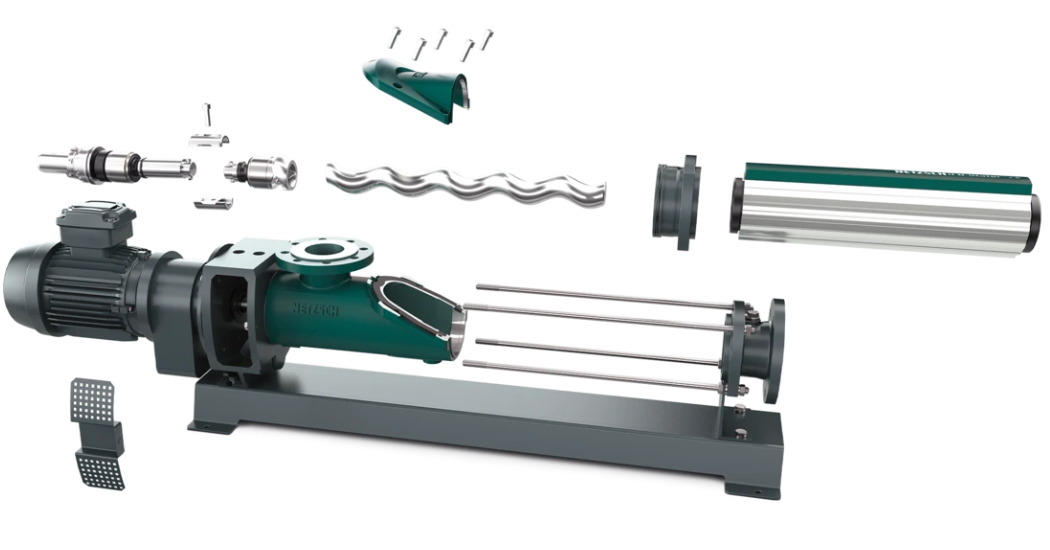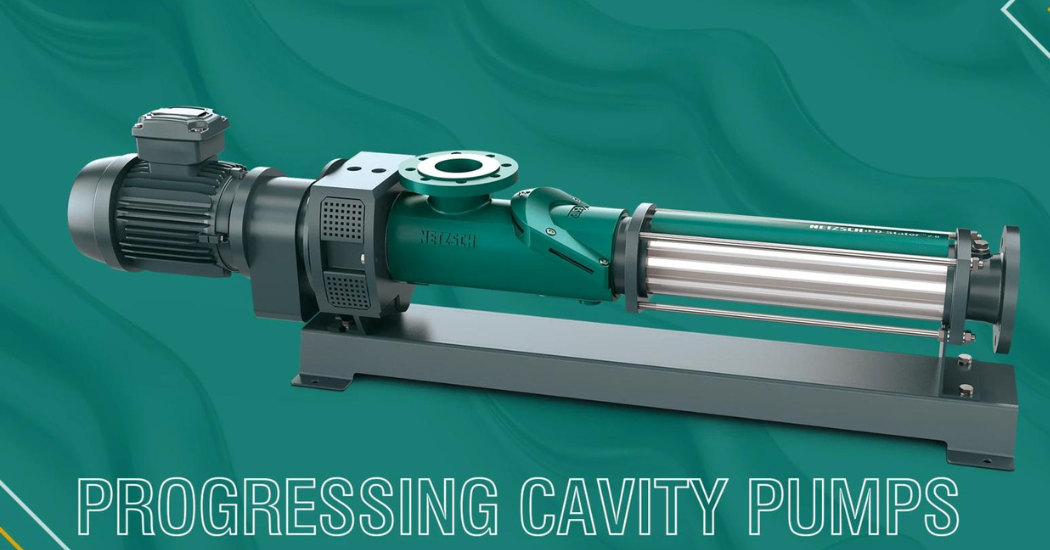How are progressing cavity pumps constructed? What advantages and disadvantages do they have? How do progressing cavity pumps work? For which applications are they particularly suitable? NETZSCH Pumps & Systems, the world market leader in the field of progressing cavity pumps, has the answers to your questions.
NETZSCH draws on more than 70 years of expertise in developing, producing and distributing progressing cavity pumps worldwide. Everything you need to know about this proven technology can be found here.
Construction of progressing cavity pumps
Progressing cavity pumps are suitable for efficiently pumping a wide variety of media. Due to their inventor, René Moineau, they are also known by other names such as Moineau pumps, Mohno pumps, Moyno pumps or mono pumps and consist of several components. The main components of progressive cavity pumps at a glance:
- Rotor
- Stator
- Pump housing
- Inlet and outlet openings
- Drive unit

In FSIP® design the pump can help to safe even more maintenance costs and costs caused by downtimes.
The rotor is the central moving component of the pump. It has an eccentric arrangement in the pump housing. The rotor can be described as a feeding screw or spiral. The second elementary component of progressing cavity pumps is the stator. It is the stationary, elastic housing that encloses the rotor. The stator has a unique internal geometry corresponding to the rotor’s external form. It is often made of rubber-like materials to ensure a tight seal between the rotor and stator. The pump housing, on the other hand, is usually made of metal. It is the outer frame of the pump enclosing the stator. It contains the stator and allows the pumped liquid to enter and exit. In addition, progressing cavity pumps, like all other pumps, have inlet and outlet openings through which the fluid enters and exits the pump. Another component is the drive unit that moves the rotor. This can be an electric motor, a hydraulic motor or other drive mechanisms.
Function of progressing cavity pumps
Progressing cavity pumps work on the positive displacement principle, in which an eccentrically rotating rotor forms a progressive cavity within an elastic stator. In the inlet phase, the pumped medium is sucked into this cavity. During the pumping process, the rotor pushes the medium in front of it as it rotates, transporting it continuously and precisely from the inlet to the outlet opening. The precise fit between the rotor and stator ensures a tight seal and enables viscous, abrasive media to be pumped efficiently with low pulsation and without damaging the pump.
With the NEMO® BY progressing cavity pump in FSIP® design, you can reduce your maintenance time by up to 66 percent.
Advantages of progressing cavity pumps
Progressing cavity pumps offer several advantages, making them attractive for various industrial applications. Thanks to the principle of positive displacement, progressing cavity pumps can be used to pump a wide range of viscous media, slurries, and suspensions gently and precisely. Their low degree of pulsation minimises wear on pump components and, at the same time, enables you to achieve consistent pumping. The tight fit between the rotor and the stator ensures efficient sealing, minimising pressure loss. You can also use progressing cavity pumps to pump sensitive media without damage. Their versatility, high efficiency and easy maintenance make them a favourite choice in various industries and applications.
Disadvantages of progressing cavity pumps
Despite their advantages, progressing cavity pumps also have some potential disadvantages. Due to their positive displacement, they can be sensitive to dry running if not sufficiently lubricated, leading to increased wear. Another factor is the limited pumping speed compared to other pump types such as multi screw pumps, which can make them difficult to adapt to high flow rate applications. In addition, certain media require unique materials for the rotor and stator to minimise corrosion and abrasion. The complex geometry of the pump can also make cleaning and maintenance more difficult. Despite these aspects, the disadvantages compared to the advantages are often highly dependent on the specific application, and many of these challenges can be minimised through careful selection, installation and maintenance. Our experts are on hand to advise and support you in choosing the right technology. And our service and support do not end with the purchase. From advice, maintenance and spare parts to repairing and modernizing your pump, we are at your side. Thanks to our worldwide service network, we are ready for you around the clock in an emergency.
The NEMO® BH hygienic pump in compact block design is used for hygienic applications because of its optimal process characteristics.
Areas of application for progressing cavity pumps
Progressing cavity pumps are used in various industries due to their versatile properties. In food processing, for example, they are suitable for gently transferring viscous substances such as sauces, doughs or creams. Conversely, progressing cavity pumps enable the gentle transfer of abrasive and aggressive media in the chemical industry. This reduces your maintenance and repair costs in the long term. In wastewater treatment, progressing cavity pumps are used for pumping sludge and sewage sludge, as they can also move solid components. Progressing cavity pumps also offer a sustainable solution in the oil and gas industry, for example, for transferring drilling mud. Progressing cavity pumps can also be found in the pharmaceutical industry, paper production and mining, where they efficiently pump a wide range of media with varying consistencies. Therefore, the application areas for progressing cavity pumps extend across various industries where precise, gentle and reliable pumping of different media is required.
Progressing cavity pumps from NETZSCH
As a global specialist for conveying complex media, NETZSCH’s portfolio includes rotary lobe pumps, multi screw pumps, peristaltic pumps, grinding systems and barrel emptying systems as well as progressing cavity pumps.
Thanks to numerous variants, applications in a wide range of sectors can be covered. Whether environment & energy, chemical, pulp & paper, food & pharmaceuticals, mining, oil & gas upstream, mid- / downstream or batteries: NETZSCH develop a customized and sophisticated pump solution for your enquiry on a global scale.




